RC cars are designed for blazing speeds and handling tight turns, putting immense stress on the tires. The tread can eventually separate from the foam and rubber tire body, reducing traction and performance. Rather than replacing the tires, gluing the tread back down is an easy, cost-effective way to restore grip and extend tire life. With the right supplies and techniques, you can securely re-adhere the treads to get your RC car’s tires back in racing condition. This guide will cover the necessary tools, how to properly prepare the tire surface, gluing steps, curing techniques, and usage/maintenance tips so you can get the most out of your glued tires. We’ll provide detailed instructions to help you make your RC car tires last longer and handle better than ever.
1. Why Glue The RC Tires?
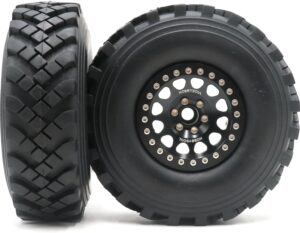
There are several key reasons to glue down the tread on your RC car tires. The adhesive keeps the rubber tread strongly attached to the tire over time, preventing the edges from peeling up while driving. This maintains proper tire tread contact. When the tread is properly adhered to the tire, it provides better grip and traction for accelerating, braking, and cornering. Smooth reliable traction translates into better handling. As tires wear out, gluing the tread can restore the tire performance close to brand new. Your RC car will handle better when the tires have consistent tread adhesion.
2. Benefits of Proper Gluing RC Tires
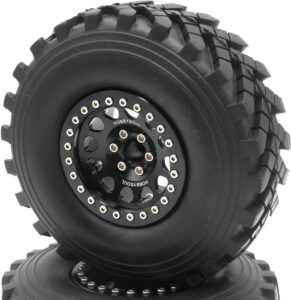
Taking the time to properly glue down your RC tire treads provides great benefits. Gluing the tread extends the usable life of the tire substantially rather than replacing worn tires. This saves money. The adhesive holds up to the forces exerted on the tread and helps prevent tread cuts/tears from use. Your tires last longer. Proper tire adhesion gives you a smoother feel and more predictable handling. Driving is more enjoyable. Some RC enthusiasts like to experiment with tire tread patterns and glue them in creative ways. The options are endless!
3. Required Tools to Glue RC Car Tires
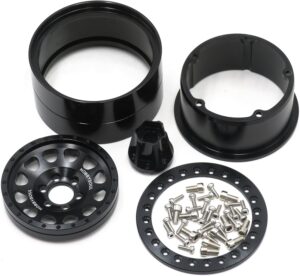
Having the right tools on hand will make gluing your RC car tires much easier. There are a few key items you will need:
Glue
Using a flexible rubber tire glue is best. Cyanoacrylate, contact cement, or hobby tire glue all work well. Make sure to choose a glue that will bond rubber and foam firmly. The glue needs to remain flexible when dry and not become brittle.
Sandpaper/Sanding Tools
Lightly roughing up the surface of the tire and tread with sandpaper helps the glue adhere properly. Fine grit sandpaper is ideal to avoid removing too much rubber. Sanding tools like a Dremel or wire brush can also be used.
Scrapers
A plastic scraper, putty knife, or stiff card can help apply glue smoothly to the tire surface. It ensures even glue coverage. Scrapers also help remove any old loose tread or debris.
Applicators
Small pieces of cardboard, popsicle sticks, or disposable foam brushes are handy for spreading glue evenly on the tires without making a mess. Q-tips also help with precise glue application.
Cleanup
Have some rags, paper towels, and cleaning solution on hand to quickly wipe up any excess glue and keep things tidy. Nail polish remover or rubbing alcohol work to remove glue.
Safety Gear
Wearing gloves and eye protection is recommended when handling glue, sanding, and scraping tires. Work in a well-ventilated area.
Taking a few minutes to gather the necessary supplies will make the gluing process much simpler and the results more successful. With the right tools, you can securely re-adhere the treads on your RC car tires.
4. Tire Surface Preparation
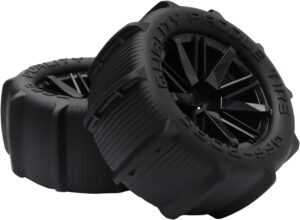
Properly preparing the tire surface is crucial for the glue to adhere correctly. Take the time to clean and roughen the rubber for best results.
Cleaning
Wipe down the tire tread and sidewalls with a cleaning solution to remove any dirt, oils or grease. This helps the glue bond directly to the rubber. Be sure to let the tires dry fully after cleaning before applying glue.
Roughing The Surface
Use a piece of fine grit sandpaper to lightly scuff the surface of the tread and tire. This gives the glue something to grip onto. Don’t remove too much rubber, just rough it up a bit. Be sure to sand both the tire sidewall and the loose tread.
Removing Old Tread
If there is tread already peeling off or badly worn, scrape off all loose pieces with a plastic scraper or putty knife. Remove any chunks or flakes of rubber. This leaves a clean surface to start fresh.
Tire Profile
Inspect the tire profile and shape prior to gluing. Stuff the tire with paper or foam to recreate its proper rounded profile if needed. This allows the tread to adhere smoothly across the entire curved surface.
Proper preparation is vital for the glue to bond correctly. Taking the time to properly clean, rough up, and shape the tire creates the optimal surface for the fresh tread to grip. Careful prep work translates to tires that hold up better and last longer.
5. Gluing Steps
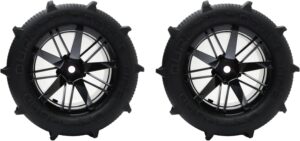
Applying the adhesive properly is key to creating a strong, lasting bond between the tire and tread. Follow these techniques for best results:
Selecting Glue
Choose a flexible rubber tire glue designed to bond tread. Cyanoacrylate, contact cement, and hobby tire glues work well. Avoid super glue or epoxy which dry too hard.
Prep Surface
Make sure the surface is clean, dry and roughed up before gluing. This helps the glue adhere.
Apply Thin Coat
Use an applicator to spread a thin, even layer of glue on both the tire sidewall and the loose tread. Too much glue will be messy.
Align Tread
Carefully align the tread onto the tire surface while the glue is still wet. Wrap a piece of string around the tire to mark tread placement.
Apply Pressure
Once aligned, press the tread firmly onto the glued surface. Apply even pressure with your fingers across the entire tread surface.
Secure in Place
Wrap the tire with string or tape and compress to hold the tread in place as the glue dries. The bond will strengthen over 24 hours.
Adding Weights
Placing a weight on top of the dried tire further compresses it to maximize the tread bond. Let sit overnight.
Gluing tires requires careful glue application, precise tread alignment, and consistent pressure while drying. Following these techniques will result in a tread that stays adhered through all your RC adventures!
6. Bonding and Curing
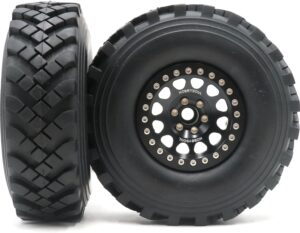
Once the tire tread is glued back into place, it needs time to fully bond and cure properly. Follow these steps for best results:
Securing While Drying
After applying glue and attaching the tread, wrap string, rubber bands, or tape around the tire to hold it in place as it dries. This applies consistent pressure as the bond sets.
Drying Time
The initial bond will dry within 5-10 minutes. However, it takes 24 hours for the glue to fully cure and create a rigid, lasting bond. Be patient and allow ample drying time.
Applying Weight
Adding weight on top of the tire during the curing process helps maximize contact between the surfaces. Place a heavy object like books or weights over the tread area.
Rotating Tire
Occasionally rotate the tire to ensure the weight is evenly distributed as the glue cures. This prevents spots from bonding less.
No Driving
Do not drive the RC car during the 24 hour bonding period! Driving pre-maturely can ruin the tread adhesion. Let it fully cure first.
The curing stage is crucial for the glued tread to properly adhere to the tire long-term. Allowing adequate drying time and weighting the tires creates an optimal, rigid bond that won’t come loose.
7. Usage and Maintenance
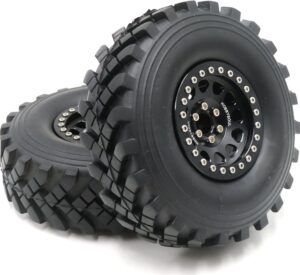
Once your RC car tires are properly glued, follow these guidelines to get the most performance and life from them:
Breaking In the Tires
Drive conservatively at first, gradually increasing speed. This allows the bond to adjust without shearing off. Hard cornering should be avoided initially.
Limit Impacts
While glued treads are durable, curbing wheels or hard landings can still cause damage. Drive smoothly without harsh impacts to prevent tread separation.
Keep Them Clean
Regularly remove dirt, debris, and grime from the tires to prevent the tread from peeling. Clean off any oil, gas spills, or tread-clogging mud.
Check Bond Lines
Inspect where the tread meets the tire occasionally. Re-glue any sections that are starting to separate before they fully detach.
Proper Storage
When not in use, store RC cars with tires inflated to shape, out of direct sunlight, and away from hot environments. This prevents cracking.
Re-gluing When Needed
As you notice tread edges starting to peel again, sand and re-apply glue before it detaches fully. Re-gluing extends tire life.
With proper care, glued RC car tires can last much longer than untended tires. Handle them with care and maintain the adhesive bond for best performance. Take steps to maximize the tread life.
Final Thoughts
Gluing down the tread on your worn RC car tires is an easy and effective way to enhance their longevity and performance. By gathering the proper adhesives and tools, thoroughly prepping the tire surface, following precise gluing techniques, letting the bond cure properly, and maintaining the tires, you can extend the life of your tires considerably. The small effort of gluing pays off exponentially with the money saved on replacing tires and the restored traction and handling. Your RC driving experience is improved with tires that grip predictably and last longer. With the steps and guidance outlined in this guide, you can now confidently glue down the treads on your RC car tires and keep them in top racing condition. Properly adhered tires will lead to more enjoyment of your RC car for many miles to come.
Enjoyed this guide of How To Glue RC Car Tires? Then be sure to check out our other RC Rating guides.